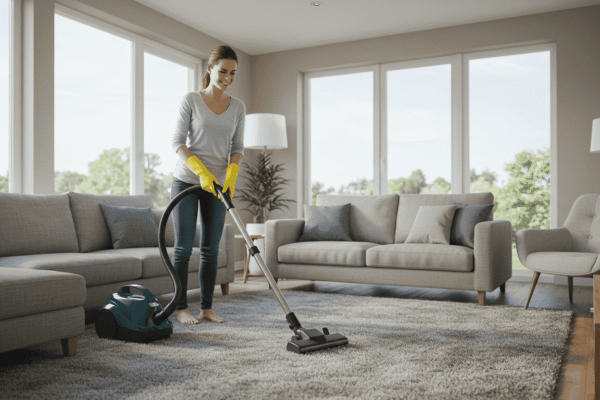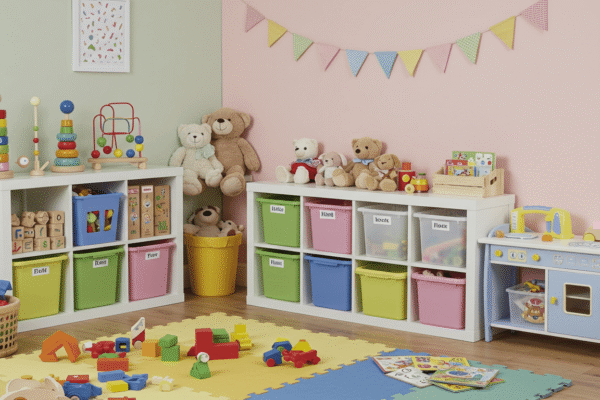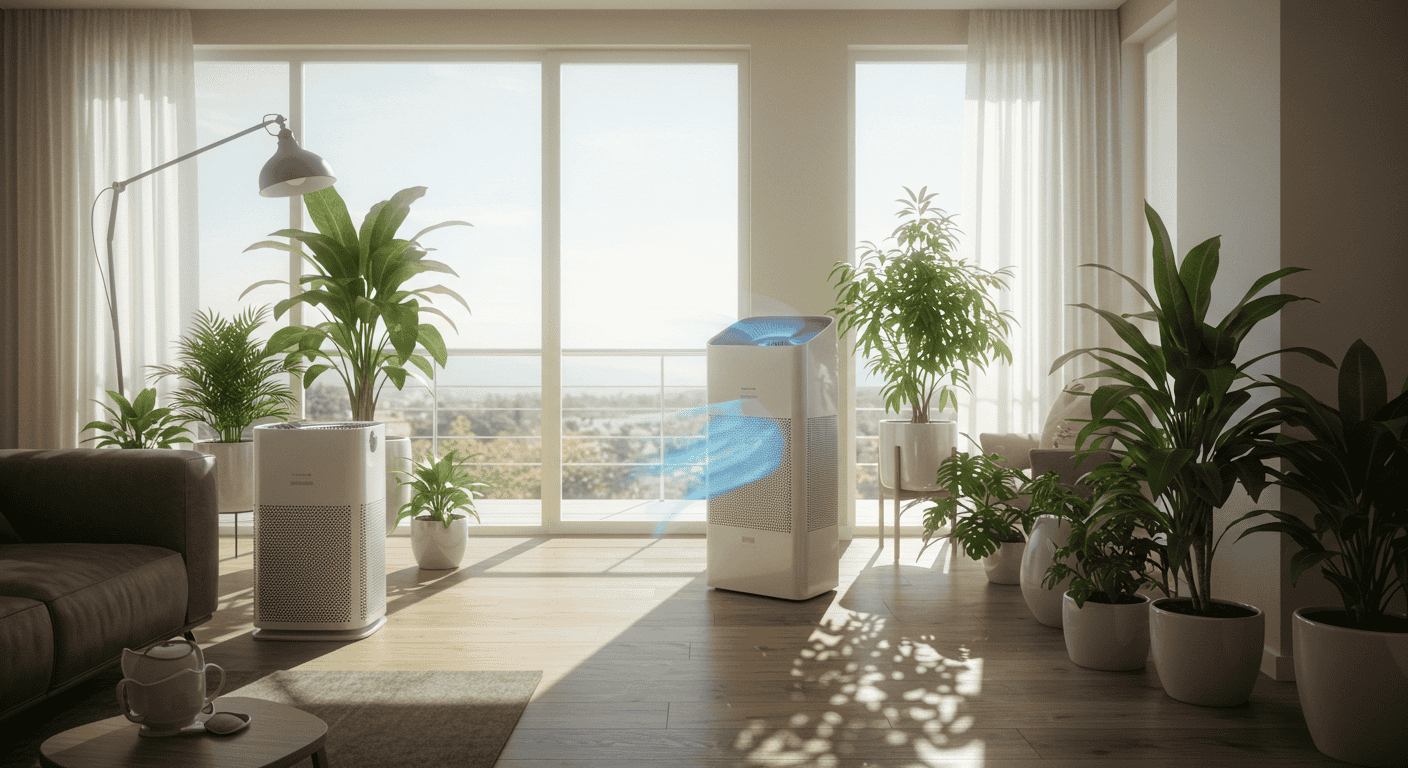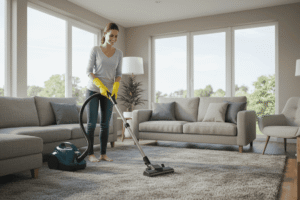Indoor Air Quality Monitoring & Solutions are essential for maintaining a healthy and comfortable home environment. Many people don’t realize that the air inside their homes can be more polluted than outdoor air, filled with dust, allergens, VOCs, mold spores, and other hidden pollutants. By understanding how to monitor indoor air quality and implement effective solutions, you can reduce health risks, improve comfort, and create a safer living space for your family. In this guide, we’ll explore practical tips, key indicators, and creative ways to keep your home air clean and healthy.
Understanding Indoor Air Quality
Maintaining indoor air quality is more important than most people realize. The air inside our homes affects our health, comfort, and overall well-being. Poor indoor air quality can lead to short-term discomfort like headaches, fatigue, or allergies, and long-term issues such as respiratory problems or chronic illnesses. By understanding what indoor air quality is and identifying common pollutants, you can take effective steps to monitor and improve the air you breathe every day.
What Is Indoor Air Quality?
Indoor air quality (IAQ) refers to the condition of the air inside a building or home, especially regarding the presence of pollutants and its impact on health. While outdoor air pollution often gets attention, indoor air can sometimes be even more contaminated due to limited ventilation, household activities, and accumulation of particles. Cooking, cleaning products, building materials, and even furniture can release compounds that lower air quality. Understanding what indoor air quality is helps homeowners take proactive steps to protect themselves and their families from potential health risks.
Common Indoor Pollutants
Several substances commonly affect indoor air quality, each with unique sources and health impacts. Dust from carpets and furniture, volatile organic compounds (VOCs) from paints and cleaning products, mold spores from damp areas, carbon dioxide (CO₂), radon, allergens, and pet dander are among the most frequent contributors. Recognizing these pollutants allows homeowners to implement targeted solutions to improve indoor air quality.
Table: Common Indoor Pollutants and Their Effects on Health
| Pollutant | Source | Potential Health Effects |
|---|---|---|
| Dust | Carpets, furniture | Respiratory irritation, allergies |
| VOCs | Paint, cleaning products | Headaches, dizziness |
| Mold spores | Damp areas | Asthma, respiratory infections |
Addressing these pollutants through monitoring, ventilation, and cleaning is essential for maintaining a healthy living environment and enhancing the overall indoor air quality in your home.
Why Indoor Air Quality Matters for Your Health
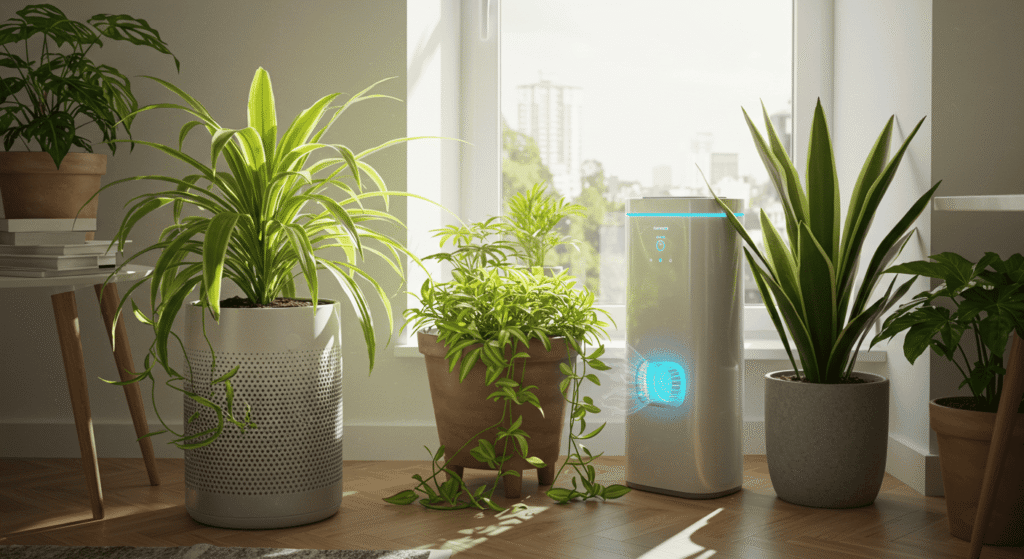
The quality of air inside your home has a direct impact on your health and overall well-being. Even if your home looks clean, poor indoor air quality can lead to a range of health problems over time. Understanding the effects of contaminated indoor air helps homeowners take proactive steps to improve air quality and protect everyone in the household.
Short-Term Effects of Poor IAQ
Short-term exposure to poor indoor air quality can trigger a variety of immediate health issues. Common symptoms include headaches, fatigue, eye and throat irritation, sneezing, coughing, and allergy flare-ups. These effects may appear within hours or days of exposure and often worsen in enclosed, poorly ventilated spaces. Recognizing these warning signs is important for taking corrective action quickly.
Long-Term Consequences
Chronic exposure to pollutants in the home can lead to serious long-term health problems. Prolonged poor indoor air quality can contribute to respiratory diseases such as asthma and bronchitis, chronic allergies, cardiovascular issues, and a weakened immune system. Over time, continuous exposure to certain indoor pollutants can also increase the risk of severe health conditions, making it critical to maintain clean and safe air indoors.
Impact on Children and Elderly
Children and elderly individuals are particularly vulnerable to the effects of poor indoor air quality. Children’s developing respiratory systems and higher breathing rates make them more susceptible to pollutants, which can affect lung growth and trigger asthma or allergies. Elderly individuals often have weaker immune systems and pre-existing health conditions, making them more prone to respiratory infections and chronic illnesses caused by contaminated indoor air. Prioritizing indoor air quality is essential for protecting these sensitive populations.
Table: Short-Term vs. Long-Term Effects of Poor Indoor Air Quality
| Exposure Duration | Health Effects | Sensitive Groups |
|---|---|---|
| Short-Term | Headaches, fatigue, eye/throat irritation, sneezing, coughing | All ages |
| Long-Term | Asthma, chronic allergies, respiratory diseases, weakened immunity | Children, elderly, immunocompromised |
How to Monitor Your Indoor Air Quality

Monitoring indoor air quality is the first step toward creating a healthier home environment. By regularly checking air conditions, you can detect problems early and take the necessary measures to reduce exposure to pollutants. Understanding the different monitoring methods and key indicators will help you maintain optimal air quality.
Manual vs. Automatic Monitoring
There are two primary ways to monitor indoor air quality: manual checks and automatic monitoring devices.
Manual monitoring involves simple observation and measurement, such as checking humidity levels, noticing unusual odors, or observing condensation on windows. The advantage of this method is that it requires no specialized equipment and is low-cost. However, it is limited by human perception and may not detect invisible pollutants like VOCs or fine particulate matter.
Automatic monitoring, on the other hand, uses sensors to continuously track air quality indicators, providing real-time data and alerts when conditions exceed safe levels. While more accurate and comprehensive, this method can be more expensive and may require some setup and maintenance. Combining both approaches can give a well-rounded understanding of your home air quality.
Key Indicators to Track
To effectively monitor indoor air quality, focus on key indicators that reflect potential health risks. The most important measures include CO₂ levels, volatile organic compounds (VOCs), humidity, and particulate matter (PM2.5/PM10). Keeping these indicators within safe ranges can prevent discomfort and long-term health issues.
Table: Air Quality Levels and Health Risk
| Indicator | Safe Level | Moderate | High Risk |
|---|---|---|---|
| CO₂ (ppm) | <1000 | 1000-2000 | >2000 |
| PM2.5 (µg/m³) | <12 | 12-35 | >35 |
| Humidity (%) | 30-50 | 50-60 | >60 |
Regularly monitoring these indicators helps identify potential issues early and allows homeowners to take proactive steps to maintain a clean and healthy indoor environment.
Practical Solutions to Improve Indoor Air Quality
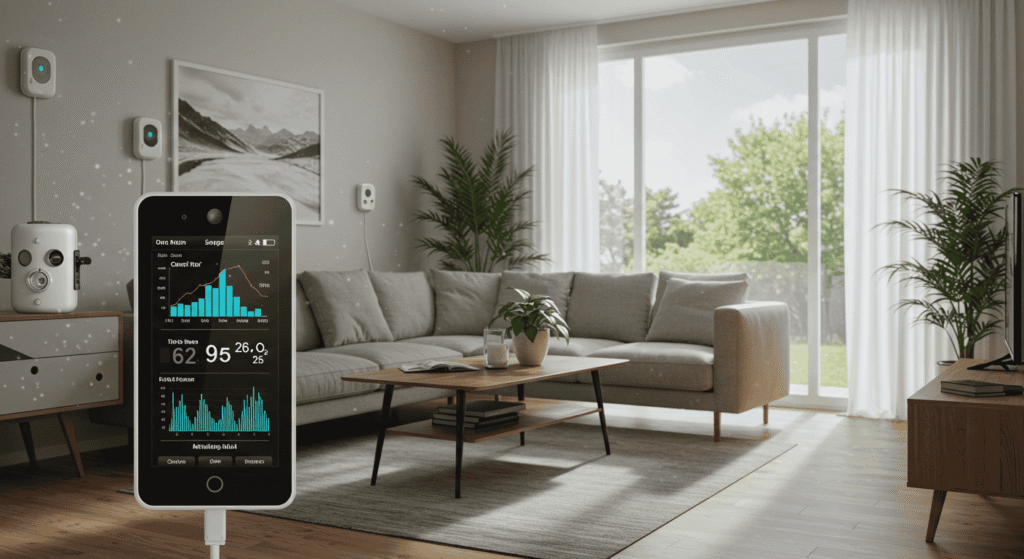
Improving indoor air quality requires a combination of simple lifestyle adjustments and consistent maintenance routines. Small changes in how you ventilate your home and clean your living spaces can have a significant impact on the air you and your family breathe daily.
Ventilation and Airflow
Proper ventilation is one of the most effective ways to maintain healthy indoor air quality. Opening windows regularly allows fresh air to replace stagnant indoor air, reducing the concentration of pollutants. Using exhaust fans in kitchens and bathrooms helps remove excess moisture, cooking fumes, and odors that can degrade air quality. Additionally, encouraging natural airflow by keeping doors open between rooms or using ceiling fans can improve air circulation and prevent the buildup of allergens and pollutants. Implementing consistent air exchange practices ensures that indoor spaces remain well-ventilated and healthier to breathe.
Cleaning Strategies for Healthier Air
A clean home directly contributes to better indoor air quality. Regular cleaning routines help reduce dust, allergens, and other particles that accumulate in carpets, furniture, and surfaces. Vacuuming with a high-efficiency filter captures fine particles that otherwise remain airborne. Damp dusting prevents dust from being dispersed into the air while cleaning. Minimizing clutter reduces places where dust and allergens can accumulate. Additionally, addressing mold in damp areas promptly prevents spores from spreading throughout the home.
Table: Cleaning Tips and Their Air Quality Benefits
| Cleaning Activity | How It Improves IAQ | Frequency |
|---|---|---|
| Damp dusting | Reduces dust and allergens | Weekly |
| Vacuuming with filter | Captures fine particles | 2-3 times/week |
| Decluttering | Minimizes dust traps | Monthly |
By combining proper ventilation with targeted cleaning strategies, homeowners can significantly enhance indoor air quality, making their living spaces safer and more comfortable for everyone.
Natural Ways to Maintain Clean Indoor Air
Maintaining indoor air quality doesn’t always require high-tech solutions. Simple, natural methods can significantly improve the air in your home. By controlling moisture, incorporating certain plants, and managing household waste properly, you can create a cleaner and healthier living environment.
Humidity Control
Humidity levels play a major role in indoor air quality. Excess moisture can lead to mold growth, dust mites, and other allergens. Maintaining an optimal humidity level of around 30–50% helps prevent these issues. Simple strategies include using dehumidifiers in damp areas, ventilating bathrooms and kitchens, and drying wet surfaces promptly. Controlling indoor humidity not only reduces pollutants but also makes your home more comfortable.
Houseplants and Air Quality
Certain indoor plants can contribute to healthier indoor air quality by helping filter airborne pollutants. While they are not a replacement for proper ventilation or cleaning, plants can absorb some volatile organic compounds (VOCs) and improve oxygen levels in the home. Choosing plants that thrive indoors and require minimal maintenance can offer both aesthetic appeal and minor air purification benefits.
Proper Waste Management
Proper management of household waste is another natural way to support indoor air quality. Keeping garbage bins sealed, disposing of waste regularly, and minimizing sources of odor or chemical fumes reduces the accumulation of harmful compounds in your home. Additionally, separating compostable materials from regular trash can help prevent mold growth and unpleasant odors, contributing to a fresher, cleaner indoor environment.
Table: Natural Methods to Improve Indoor Air Quality
| Method | How It Improves IAQ | Frequency/Tip |
|---|---|---|
| Humidity control | Reduces mold and allergens | Maintain 30–50% humidity |
| Houseplants | Absorb certain pollutants | Place in low-light areas |
| Proper waste management | Limits odors and VOC buildup | Seal bins and dispose regularly |
These natural approaches, when combined with ventilation and cleaning routines, create a strong foundation for maintaining consistently healthy indoor air.
Lifestyle Habits That Affect Indoor Air
Everyday lifestyle habits in your home can have a significant impact on indoor air quality. Small adjustments in daily routines, cooking methods, and product choices can reduce pollutants and create a healthier environment for your family.
Smoking, Cooking, and Pet Habits
Certain habits directly influence the quality of the air indoors. Indoor smoking releases harmful chemicals, including carbon monoxide and VOCs, which can linger in the home for hours and increase health risks. Cooking methods that produce smoke or strong fumes, such as frying or using gas stoves without proper ventilation, can also elevate indoor pollutants. Additionally, pets contribute allergens such as dander and hair, which may trigger respiratory irritation or allergies in sensitive individuals. Being mindful of these activities and implementing proper ventilation or air management can greatly improve home air quality.
Choosing Safer Household Products
Household products, including cleaning supplies, paints, adhesives, and air fresheners, can emit VOCs and other chemicals that reduce indoor air quality. Opting for products with lower VOC content, using natural alternatives where possible, and following manufacturer guidelines for ventilation can help minimize exposure. Simple strategies like storing chemicals in well-ventilated areas and limiting strong-scented products can also contribute to cleaner indoor air.
Table: Lifestyle Habits and Their Impact on Indoor Air Quality
| Habit | How It Affects IAQ | Recommended Action |
|---|---|---|
| Indoor smoking | Releases harmful chemicals, VOCs | Avoid smoking indoors or ventilate immediately |
| Cooking with smoke | Produces fumes and particulates | Use exhaust fans or open windows |
| Pets | Contribute dander and hair | Groom pets regularly and vacuum frequently |
| Household products | Emit VOCs and odors | Choose low-VOC products and ventilate |
By adjusting these lifestyle habits, homeowners can make a noticeable difference in indoor air quality, reducing health risks and creating a more comfortable living space.
Common Indoor Air Problems and How to Fix Them
Even with careful monitoring and preventive measures, many homes still experience indoor air quality issues. Understanding the most common problems and how to address them can help maintain a healthy and comfortable living environment.
High Humidity and Mold Growth
High humidity is one of the primary causes of poor indoor air quality. Excess moisture creates ideal conditions for mold and mildew, which can release spores into the air and trigger respiratory issues. Detecting mold early often involves checking damp areas, walls, and ceilings for discoloration or a musty smell. Preventive strategies include using dehumidifiers, ventilating bathrooms and kitchens, fixing leaks promptly, and drying wet surfaces. Maintaining optimal humidity levels between 30–50% helps reduce the risk of mold growth and protects both your home and health.
Dust and Allergens
Dust, pet dander, and other allergens accumulate in furniture, carpets, and ventilation systems, impacting indoor air quality. Regular cleaning is essential to reduce airborne particles. Strategies include vacuuming with HEPA filters, damp dusting to prevent particles from being dispersed, and decluttering to eliminate dust traps. Attention to these details helps reduce allergy flare-ups and respiratory irritation in the home.
Stale or Odorous Air
Stale or unpleasant odors indicate poor air circulation and can reduce indoor air quality. Common causes include insufficient ventilation, lingering cooking fumes, or trapped moisture. Solutions involve opening windows to increase airflow, using exhaust fans, and employing natural odor absorbers such as baking soda or activated charcoal. Optimizing airflow throughout the home prevents pollutants from accumulating and keeps the indoor environment fresh.
Table: Indoor Air Problem vs. Practical Fix
| Problem | Cause | Solution |
|---|---|---|
| Mold | High humidity | Dehumidify, clean surfaces |
| Dust buildup | Poor cleaning | Regular dusting, vacuuming |
| Stale air | Poor ventilation | Open windows, airflow circulation |
By addressing these common issues proactively, homeowners can maintain cleaner, healthier air and ensure a more comfortable indoor environment for everyone.
Creating a Long-Term Indoor Air Quality Plan
Maintaining indoor air quality is an ongoing process that requires planning, monitoring, and consistent effort. Establishing a long-term strategy ensures your home remains a healthy environment year-round. By incorporating regular checks, seasonal adjustments, and involving all household members, you can proactively prevent air quality problems.
Regular Monitoring Schedule
Regular monitoring is essential to maintain optimal indoor air quality. Checking key indicators such as CO₂ levels, particulate matter, humidity, and VOCs on a scheduled basis helps detect issues early before they become serious. For most households, a weekly or bi-weekly check is sufficient, while sensitive environments, such as homes with children, elderly, or individuals with respiratory conditions, may require more frequent monitoring. Consistent tracking ensures timely interventions and keeps the air safe to breathe.
Seasonal Adjustments
Air quality needs can change with the seasons due to variations in temperature, humidity, and ventilation patterns. In winter, closed windows and reduced airflow may increase indoor pollutants, while high humidity in summer can promote mold growth. Adjusting ventilation, dehumidification, and cleaning routines according to seasonal conditions helps maintain healthy home air quality throughout the year.
Involving the Whole Household
Creating a healthy indoor environment requires participation from everyone in the household. Encouraging family members to adopt habits that support indoor air quality—such as proper cleaning, reducing chemical usage, ventilating rooms regularly, and managing pets—ensures that improvements are sustained. Teaching children simple practices like closing doors to prevent dust spread or wiping surfaces after spills can make a significant difference over time.
Table: Long-Term Indoor Air Quality Plan Checklist
| Task | Frequency | Benefit |
|---|---|---|
| Monitor air indicators | Weekly/Bi-weekly | Detect issues early |
| Ventilate rooms | Daily | Improve airflow and reduce pollutants |
| Clean surfaces | Weekly | Reduce dust, allergens, and VOCs |
| Adjust routines seasonally | Seasonal | Prevent mold and humidity issues |
| Family participation | Continuous | Maintain consistent healthy habits |
By implementing a structured long-term plan, homeowners can ensure that their indoor environment remains safe, comfortable, and supportive of overall health.
Conclusion – Breathing Easier at Home
Maintaining indoor air quality is essential for a healthy and comfortable living environment. Throughout this guide, we’ve explored the importance of monitoring indoor air quality, implementing effective cleaning strategies, making lifestyle adjustments, and establishing a long-term air quality plan. Each of these steps contributes to reducing pollutants, preventing health issues, and ensuring that the air in your home supports the well-being of everyone in your household.
Taking action doesn’t have to be complicated. By combining regular monitoring, proper ventilation, consistent cleaning, humidity control, and mindful household habits, you can create a safer, fresher, and more enjoyable indoor environment. The key is to maintain these practices consistently and involve all family members in the process.
Table: Quick Reference – Indoor Air Quality Checklist
| Task | Frequency | Benefit |
|---|---|---|
| Monitor air indicators | Weekly | Detect problems early |
| Ventilate rooms | Daily | Improve airflow |
| Clean surfaces | Weekly | Reduce dust/allergens |
| Control humidity | As needed | Prevent mold growth |
By following these simple yet effective strategies, homeowners can ensure that their indoor air quality remains optimal year-round, creating a home where everyone can breathe easier and feel healthier.




